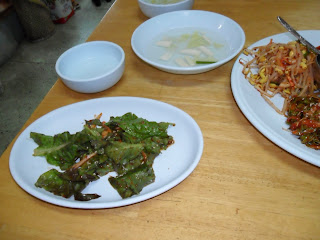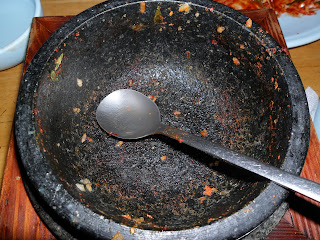Looking for a big delicious feed on the cheap in rural Cheollabuk-do? No? Well we are, and we've found it. More on that in a bit, but first, the story of the time I lost my bibimbap virginity.
The flight from Sydney to Seoul was less than awesome, with the separate seating, annoying children, and state-of-the-art mid-90's inflight entertainment, but it did have two upsides. The first was the friendly Korean couple sitting next to me. They were from Jeonju and gave me the heads up on a few things. The second redeeming feature was bi bim bap, a rice dish invented in Jeonju, and which Cheollabuk-do's tourist promotional stuff keeps telling me the province is world famous for (I'd never heard of the dish or the province before I found out I was moving here).
The airline's version of bi bim bap was one bowl with a mixture of different veges and beef mince and another with rice. Bi Bim Bap is normally vegetarian, though they also do this one and (legend has it) one with raw beef. All this came with a toothpaste tube full of red pepper paste (delicious), some sesame oil, and a bowl of forgettable soup. The idea was that you mix the veges and rice together with the sesame oil and as much red pepper paste as you can stand (heaps in my case, that stuff is delicious). I enjoyed it, but mainly because I was imagining how good it could be if it was done well. It was good for airline food, but that's obviously not much of an endorsement. Overall my first bi bim bap experience was an important moment in my life, but it was over too soon and left me feeling unsatisfied.
Things were about to get a whole lot better. Our co-teachers took us out for lunch in the middle of that whirlwind first day in Jeonju. In between having dwaeji galbi (pork belly wrapped in lettuce leaves with garlic and red pepper paste) and cold noodles (delicious and refreshing), we had our second bi bim bap. Each course of this meal was more food than I would normally eat for a big dinner, but it was delicious enough that we got through it. This bi bim bap had barley instead of rice, and the veges were done properly: a small plate for each different vegetable so you can add more of what you like. This was a big improvement on the airline's version: fresh and delicious with lots of interesting flavours.
As good as that was, things were still on the way up. After we'd been in Buan about a week we had lunch with Matt, the teacher who used to have Anna's job (and our apartment). He showed us what quickly became our favourite restaurant in Buan. I have no idea what its called, but it's around the corner from Anna's school and they only serve one thing: stone bowl bi bim bap. This turned out to be an advantage: the proprietors speak very little English than, so it's good to be only one simple question away from a delicious meal: “how many?” On one wall of the place is a big cabinet full of jars of . . . something? We didn't know what to make of it and as such it is presented here without comment.
The airline's version of bi bim bap was one bowl with a mixture of different veges and beef mince and another with rice. Bi Bim Bap is normally vegetarian, though they also do this one and (legend has it) one with raw beef. All this came with a toothpaste tube full of red pepper paste (delicious), some sesame oil, and a bowl of forgettable soup. The idea was that you mix the veges and rice together with the sesame oil and as much red pepper paste as you can stand (heaps in my case, that stuff is delicious). I enjoyed it, but mainly because I was imagining how good it could be if it was done well. It was good for airline food, but that's obviously not much of an endorsement. Overall my first bi bim bap experience was an important moment in my life, but it was over too soon and left me feeling unsatisfied.
Things were about to get a whole lot better. Our co-teachers took us out for lunch in the middle of that whirlwind first day in Jeonju. In between having dwaeji galbi (pork belly wrapped in lettuce leaves with garlic and red pepper paste) and cold noodles (delicious and refreshing), we had our second bi bim bap. Each course of this meal was more food than I would normally eat for a big dinner, but it was delicious enough that we got through it. This bi bim bap had barley instead of rice, and the veges were done properly: a small plate for each different vegetable so you can add more of what you like. This was a big improvement on the airline's version: fresh and delicious with lots of interesting flavours.
As good as that was, things were still on the way up. After we'd been in Buan about a week we had lunch with Matt, the teacher who used to have Anna's job (and our apartment). He showed us what quickly became our favourite restaurant in Buan. I have no idea what its called, but it's around the corner from Anna's school and they only serve one thing: stone bowl bi bim bap. This turned out to be an advantage: the proprietors speak very little English than, so it's good to be only one simple question away from a delicious meal: “how many?” On one wall of the place is a big cabinet full of jars of . . . something? We didn't know what to make of it and as such it is presented here without comment.

When we went with Matt we sat on the floor at low tables for the traditional Korean experience, though we’ve been back since and sat at the regular Western-style tables that are also available. This got us some dirty looks from the Korean patrons – being uncomfortable is a major part of Korean culture, see: beds, couches. The first thing that comes out is a big plate of different Korean veges, all of them covered in red pepper paste (as you might've guessed by now, it's everywhere) and a bowl of soy sauce. Next comes side dishes: kimchi, mung beans in a soy soup, some kind of lettuce thing and whole chillies (I have no idea what you're supposed to do with these since your only utensils are chopsticks and a spoon.
 This is the plate of veges you get: bean sprouts, zuchini, mung beans and an unidentified (but delicious) green sprouty thing, all covered in red pepper paste. The rest of it is is kimchi, the whole chilies, more red pepper paste and the mung bean and soy soup.
This is the plate of veges you get: bean sprouts, zuchini, mung beans and an unidentified (but delicious) green sprouty thing, all covered in red pepper paste. The rest of it is is kimchi, the whole chilies, more red pepper paste and the mung bean and soy soup.
Lettuce-like vege, pickled radish.
Then the main event: they take a big stone bowl, heat it up, and fill it with rice, a few veges and some beans. Then they crack an egg on top of it.
Then the main event: they take a big stone bowl, heat it up, and fill it with rice, a few veges and some beans. Then they crack an egg on top of it.

The egg cooks as you add your choice of the veges on the table, chuck in some of the soy sauce and mix the whole thing up.
 The end result is a super tasty mix of rice, veges, egg, beans, soy sauce and red pepper paste. It's a huge serving...
The end result is a super tasty mix of rice, veges, egg, beans, soy sauce and red pepper paste. It's a huge serving...
This picture taken when I was full
...but it's also amazingly good, so I kept going. The trick is to eat from the middle of the bowl, leaving a layer of rice around the side. This rice cooks on the side of the hot stone bowl and goes all crispy.
...but it's also amazingly good, so I kept going. The trick is to eat from the middle of the bowl, leaving a layer of rice around the side. This rice cooks on the side of the hot stone bowl and goes all crispy.

After you eat the rest of the bi bim bap you chip the crispy rice off the sides of the bowl and eat it.

It's serious business.
It's soaked up lots of the soy sauce so it's crunchy and salty and good.
 Reeeeeal good.
Reeeeeal good.And the best part: it's 6000 won. That's like, seven bucks to you. Back home there are a million Malaysian restaurants that do roti chanai (a bowl of Malaysian curry with roti bread) for about that price. It's always a big feed and some of the places do it amazingly well (KK Malaysia on Ghuznee St is the best). Stone bowl bibimbap is the tastiest and the best value feed in town: Buan's answer to roti chanai.

No comments:
Post a Comment